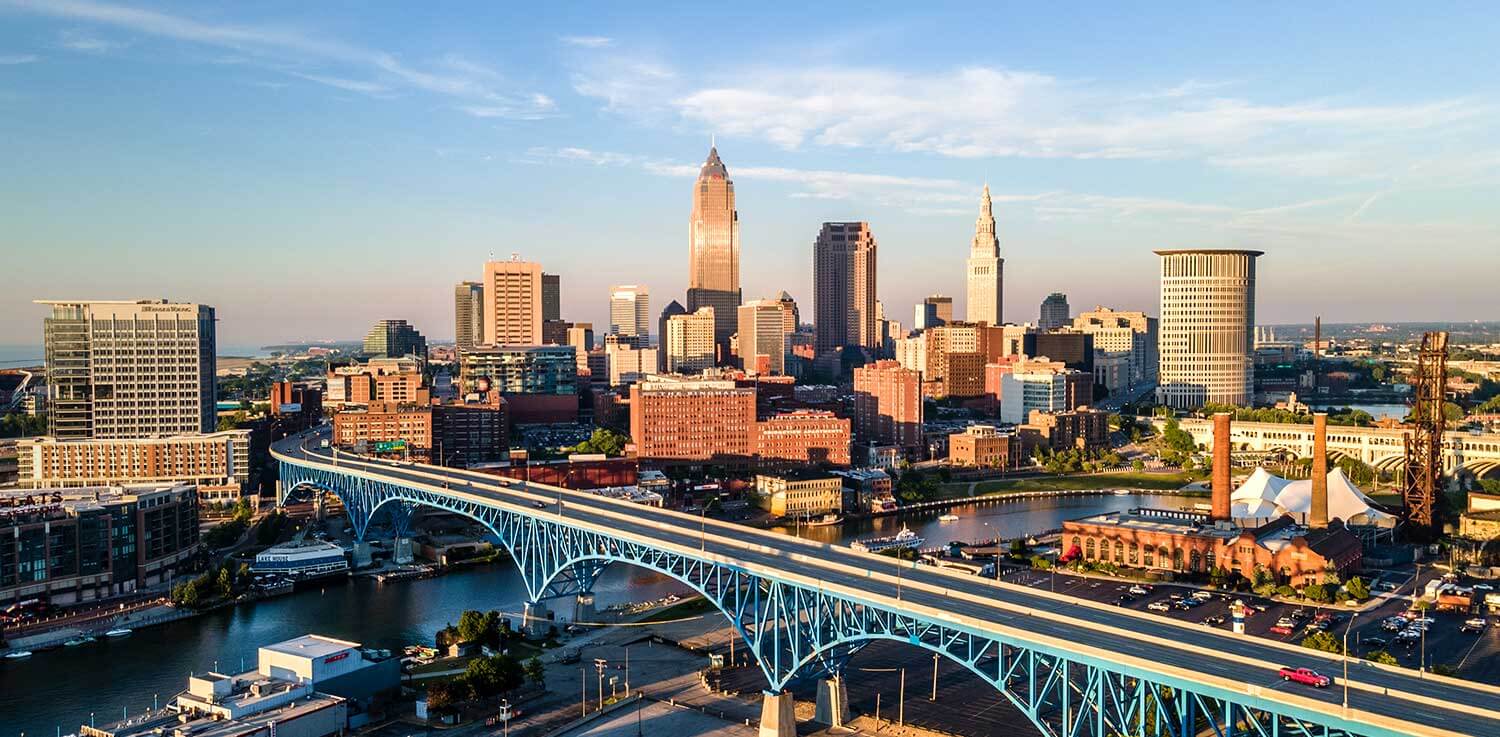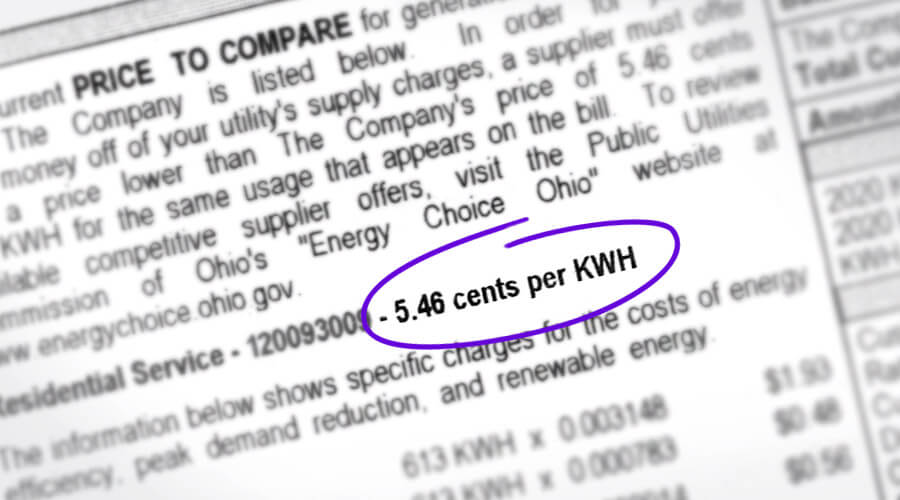How to make the move easier, from comparing electric rates in Cleveland, Ohio, to deciding if you’re an East Sider or West Sider
Most of the U.S. knows Cleveland as the perpetual underdog city, and many Clevelanders can relate. When others wonder why the city is home to the Rock and Roll Hall of Fame, Clevelanders will rattle off names like The Black Keys, The O’Jays and Rascal Flatts. When folks talk about the city’s sports curse, Clevelanders will give you all the comeback highlights from the Cleveland Cavaliers 2016 Championship season.
Maybe most of all, if you ask about its burning river, Clevelanders will point to the more than 40 species of fish that swim through the Cuyahoga River’s waters, including steelhead trout and northern pike, which live in clean water exclusively.
Clevelanders are also quick to tell you that being an underdog city has its privileges, like affordable living. Cleveland’s cost of living is almost 7 percent less than the national average and those pricier ZIP codes.
A growing economy and community
The Greater Cleveland Metro area, which includes Cuyahoga, Geauga, Lake, Lorain and Medina counties, is the 28th largest metropolitan area in the U.S., with more than 2 million residents, 379,000 living in Cleveland proper, and the second largest city in Ohio, after Columbus. Job seekers can explore opportunities with more than 37% of Fortune 500 companies, all of whom have headquarters or divisions located in and near the city, including Sherwin-Williams and Parker.
Major industries in Cleveland include healthcare, financial services and education. Cleveland Clinic is the region’s largest employer, followed by University Hospitals. Progressive Insurance and KeyCorp stand near the top, as well. Case Western Reserve University and Cuyahoga Community College bookend the city’s diverse educational offerings.
Thinking about making the move? Here’s everything you need to know to make the transition easier, from finding a Cleveland, Ohio, electric company or healthcare provider, to getting to know the neighbors.
Compare Residential Plans
Enter your zipcode to find 100% Green plans in your area.
The choice is yours: Compare electric rates in Cleveland, Ohio, and pick your energy provider
The ability to choose your energy company is a big benefit for those moving to Cleveland. Whether you’re coming from out of state or moving from one part of Ohio to Northeast Ohio, you’ll want to include this opportunity on your to do list.
Ohio is an Energy Choice state, which means residents have the freedom to compare electric and natural gas providers and choose the electricity supplier and plan that best fits their individual situation, whether that’s choosing a fixed-rate plan to make monthly budgeting more predictable, or selecting a supplier that offers environmentally friendly clean energy.
How electricity reaches your home
Generation Companies
Create electricity to sell in the market.
Suppliers
Buy the energy wholesale and offers it to consumer.
Utility Companies
Deliver power from grid to user and power lines and utility poles.
If you live in Greater Cleveland, you can choose your supplier, sometimes called your Competitive Retail Electric Service, or CRES, supplier. CRES suppliers are certified by the Public Utilities Commission of Ohio (PUCO) and offer alternative competitive prices, clean energy options and other services or incentives. Energy Harbor, for example, is a CRES supplier. It is also an energy generation company.
Comparing and choosing an energy provider is simple. Cleveland residents still receive the same bill from their local utility company, making the transition even easier. Electric utility companies in Ohio include AEP Ohio, AES Ohio, Duke Energy, The Illuminating Company, OhioEdison and ToledoEdison.
Compare Residential Plans
Enter your zipcode to find 100% Green plans in your area.
Do these 5 things before moving to Cleveland
From picking an electric company in Cleveland to visiting the BMV, getting a jump start on move-in tasks will make the transition to The Forest City even easier.
- Inform your insurance provider: Talk to your insurance company to discuss both homeowner’s and auto policy options. Laws governing how insurance providers operate vary state to state, so moving to Cleveland may require updated policies – and maybe a a new insurance provider.
- Set up home energy services: Don’t forget to compare energy solutions before connecting with your gas and electric utility. You might miss out on competitive fixed-rate plans that can help eliminate rate surprises on your electricity bill. If you want to save even more, consider other ways to lower your energy bill.
- Forward your mail and update your address online: Set up mail forwarding before you hop in the moving van. It’s as simple as filling out a Change of Address e-form at USPS.com. Then update your shipping address with online stores, subscription services, like Dollar Shave Club, and delivery apps. Nothing’s worse than having DoorDash deliver your move-in meal to your old address.
- Turn on cable and internet: Not as vital as electric power, but find time before your move to choose a communications provider and establish internet and WiFi services. With WiFi up and running on Day 1, you can unwind with your favorite streaming show or knock out some remote work on Day 2.
- Visit the BMV: Soon after you’re settled, find the closest Ohio Bureau of Motor Vehicles branch and take time to register your vehicle and get a new license. Visit the Ohio BMV’s website to choose a branch, review BMV services and learn more about Ohio traffic laws.
Moving Center
Check out the Energy Harbor Moving Center for more tips
West Side or East Side? You choose!
Flowing south to north, the Cuyahoga River divides Greater Cleveland – and divides its residents as well. All in good fun, of course. Cleveland’s East Side leans on the city’s rich history, while the West Side tends to feel a bit more modern.
Which is right for you? Here are three differences:
Choosing sides:
A quick glance at This Is Cleveland’s suburbs guide will help define Greater Cleveland’s dual personality. Easy access to two of Cleveland Metroparks’ biggest beaches, Huntington in Bay Village and Edgewater near downtown – not to mention 2,500-acre Rocky River Reservation – on the West Side attracts avid outdoor adventurers. Those looking for more indoor adventures – shopping, for example – will find endless options at Legacy Village in Beachwood and Pinecrest in Orange.
Art and history
Many consider University Circle on Cleveland’s near east side the cultural heart of the city. This simple square mile hosts the world-renowned Cleveland Museum of Art and Severance Hall, home of the award-winning Cleveland Orchestra. The Cleveland Museum of Natural History, the Cleveland Botanical Garden, MOCA Cleveland, the Baseball Heritage Museum and several other cultural institutions are all right here and waiting for visitors.
Foodies on both sides:
West Siders often name Salt one of Cleveland’s must-experience eateries. Salt chef Jill Vedaa composes “visually compelling dishes,” says Eater.com. Actor Tom Hanks, who spent summers with the Great Lakes Shakespeare Festival, often name checks Angelo’s Pizza and is known to stop in when he’s in town. Both restaurants are in Lakewood, Ohio. East Siders wake with Rising Star Coffee and pick up a Vero Pizza Napoletana pie in Cleveland Heights when they’re craving a slice.
When it comes to sports, it doesn’t matter:
Regardless of which side of the city they live, Clevelanders cherish their professional sports teams. They embrace the mantra “Nothing is given. Everything is earned,” made famous by Akron, Ohio, native LeBron James. James famously took the Cleveland Cavaliers from a 3 to 1 deficit in the 2016 NBA Finals to win the franchise’s first championship. East and West Siders root for their newly named Cleveland Guardians – the major league baseball team, not the roller derby team – and the always exciting Cleveland Browns.
Fascinating facts about Cleveland
The more you learn about Cleveland, the more you’re surprised by this Great Lake city. Here are four of fascinating facts about your new home town:
Cleveland: Metropolis’s secret identity:
Jerry Siegel and Joe Shuster created Superman while attending Cleveland’s Glenville High School. The creators found inspiration for Metropolis in Cleveland and some early comic strips show Clark Kent working for the Cleveland Evening News.
Speaking of X-ray vision:
After Konrad von Roentgen created the first X-ray machine in 1895, Dayton Miller, a professor of mathematics and physics at Cleveland’s Case School of Applied Science, conducted the first full-body X-ray. This revolutionized medicine. Now physicians knew they could use the technique to identify everything from broken bones to cancer.
Coburn Haskell? Scotland’s calling:
While golf originated in Scotland, the modern golf ball originated in Cleveland. Golfer and Cleveland resident Coburn Haskell and Bertram G. Work, a B.F. Goodrich employee, created the wound-rubber design that golf ball manufacturers still employ today. The design is often credited for the game’s U.S. popularity.
Energy is yours for the picking:
Ohio is one of only seven states in the U.S. that provides residents with energy choice through Community Choice Aggregation (CCA). Similar to choosing between other products and services, Columbus residents can shop for energy providers by comparing electricity rates in Cleveland and choosing the best option for their situation.
If you’re making the move to Columbus, take some time to compare power options at Energy Harbor. A simple fixed-rate plan can help residents avoid seasonal utility hikes by paying a predictable rate for the full length of the plan.
You don’t have to move to make a choice, however. If you are already a Columbus resident – or call any Ohio town home – compare energy rates today and make the switch.
Compare Residential Plans
Enter your zipcode to find 100% Green plans in your area.
Here’s a full list of zip codes in the Dayton area we serve:
44101, 44102, 44103, 44104, 44105, 44106, 44107, 44108, 44109, 44110, 44111, 44112, 44113, 44114, 44115, 44116, 44117, 44118, 44119, 44120, 44121, 44122, 44123, 44124, 44125, 44126, 44127, 44128, 44129, 44130, 44131, 44132, 44133, 44134, 44135, 44136, 44137, 44138, 44139, 44140, 44141, 44142, 44143, 44144, 44145, 44146, 44147, 44181, 44188, 44190, 44191, 44192, 44193, 44194, 44195, 44197, 44198, 44199


















